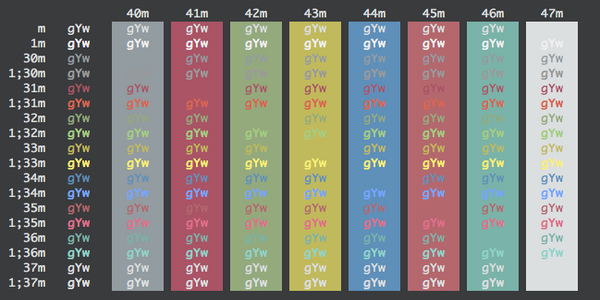

I will show you how to create triggers for the above keywords, you can modify the regex to match the keyword that is getting used in your application while printing logs. Usually, loggers in Java follow a pattern where for every error they print out “error” keyword in the logs and likewise “warn” for warning and “Fatal” if something terrible has happened 🙂 So, you’ll be creating triggers for different regex patterns which are used in the logs. You can create a different profile other than Default if you wish to do so. Apply them in iTerm through iTerm preferences profiles colors load presets. Design & Make Fun Color Changing Suncatchers and Window Clings Includes 12 Sun Catchers to Hang and Display, 6 Bright Color Paints, 2 Color Changing Paints and Design Templates. itermcolors files, then go preferences>profile>colors>color presets to find your scheme. Once the import finishes, you can click on 'Color Presets' and choose any color scheme. preferences>profile>colors>color presets, choose the scheme or import the scheme you download. ( iTerm2 > Preferences > Profiles > Colors > Color Presets) Figure 6 Click on the 'Import' option and then import all the files from the 'iTerm2-Color-Schemes/ schemes ' folder (it's the folder you downloaded earlier). The color settings will be imported into iTerm2. If I understand you correctly, you want to change the color theme. In iTerm, a trigger is an action that is performed when text matching any regular regex pattern is received in the terminal session. Just save it somewhere and open the file (s). In this article, I’m going to show you a way by which you can grep the individual lines from the logs using regex pattern match and change the color of that line instantaneously. This is the best situation where colors play an important role. You can change the colors by clicking on the color wells. Click the Edit Profiles button, then the Colors tabs. Note: the following steps are done in Ubuntu. For iTerm2 Text color changes: From the menus choose Profiles Open Profiles. If you don't like it you can revert to the system color picker by clicking the rectangular icon to the right of the eyedropper. The moment when the live traffic is shifted to your servers and you sit there eagerly watching the logs roll off in speed, only one thing in your mind that no warnings and errors should go by unnoticed. To change the colors you want to set these two environment variables in /. Clicking on any of the color wells opens a color picker that lets you change the setting for the selected color. It'd be handy for sure.Coloured logs are very helpful especially when you are going to deploy your application in production. I tell ya: mad props if anyone can figure out how to do this. The changing of a tab title does appear to be controlled by $PROMPT_COMMAND, as set in the remote session's environment, but there appear to be no documented hooks in iTerm 2 that let you extend what iTerm does when it changes the tab title. colorscheme onedark syntax on set number highlight Normal ctermbgNone highlight LineNr ctermfgDarkGrey Now our Vim should look much prettier :) Conclusion As you can see, the whole process. From changing an overhead light fitting or carrying out emergency repair.

#Iterm change color mac#
Notice how it's all based around the environment in your client's Mac shell - once you're on the remote machine there's not a lot iTerm can do. This design template will be printed in CMYK Color Model & RGB Color Model. But it does require you remember to use that profile for your rooted session.Įdit: while digging around I found this interesting article that talks about how you can change the background image in iTerm to show the hostname of the host you've ssh'ed in to.

It requires no changes to the root environment on the remote machine. By convention, most modules have a prefix of default terminal color (e.g. You can create an iTerm profile that has red text on whatever background colour you want and you always use that profile when you're going to go to root on a machine. Robo Alive Robo Fish - Blue - with Color Change by ZURU 7. You can change default configuration file location with STARSHIPCONFIG. iTerm has no way of knowing you've gone to root in a remote session - it's not watching what you're doing that closely (and what you're asking it to figure out is actually really complicated to program). Not as part of the iTerm 2 configuration.


 0 kommentar(er)
0 kommentar(er)
